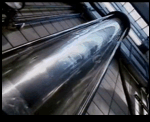Vault structuring
The vault structuring is a method of forming technology , are introduced with the optional quadrangular or hexagonal three-dimensional structures in thin-walled materials, such as sheet metal, plastic film, paperboard and paper. It stands out from the conventional sheet metal forming processes (e.g. embossing , beading , hydroforming ) through an energy-minimized self-organization process that is particularly gentle on materials, energy and resources. The most important property of a vault structure is increased rigidity (bending and buckling rigidity ).
Square vaulting phenomenon
For the basic process of vault structuring, all you need is a thin-walled cylinder and rigid support rings that fit tightly on the inside of the cylinder. If the cylinder is subjected to external pressure, the material between the support rings has to move inwards. After overcoming an instability point, square vaulted structures spontaneously form. In technical jargon, the effect is also called the penetration of bumps . The circumferential, straight folds are created by molding the support rings, while the staggered axial folds set themselves up automatically ( self-organization ) and at the same time evenly offset without the intervention of tools behind them .
a) support rings; b) slipped over cylindrical shell at low pressure; c) Square vault structure
Evolutionary development towards a hexagonal vault structure
In the search for new and better vault structures, an evolutionary approach was chosen. The more freedom the material is given to deform, the more the shape of a honeycomb pattern is formed. The honeycomb pattern has a symmetrical arrangement of the folds, and so the thin-walled material is stiffened isotropically much better .
Continuous production of vault-structured materials
In the same way as the hexagonal vaulted structures arise in the axial direction (see structure formation from top to bottom in the animation), there is also a structure formation in the circumferential direction through modification. This led to the development of a continuous vault structuring process for the manufacture of panels or strips.
Properties of vault-structured materials
Through higher dimensional stiffness to reduce weight: When vaulting, multi-dimensional stiffeners are created, which give the material a high level of flexural and buckling resistance on all sides. Components from z. B. metal, plastic or fibrous materials can therefore - with the same functionality - be used to save material. This also reduces the transport weight.
Less noise due to reduced structure-borne noise : Compared to the smooth starting material, due to the stiffening structures, the lower natural frequencies are shifted to the higher frequency range when an acoustic excitation occurs. In this way, the unpleasant roar of thin-walled components (e.g. air conditioning ducts or facade elements) is reduced. At the same time, the vault-structured material has damping properties, which reduces the emission of structure-borne noise.
Complete preservation of the surface quality : Vault structuring not only protects the material, but also its surface, because the structuring process does not involve conventional, flat tool engagement. The starting material can therefore be given a high-quality surface treatment such as B. experience painting, anodizing or labeling. That is more economical and at the same time protects the environment.
Design and virtually glare-free light reflection: In addition to the bionic design, mirrored vaulted structures split the light into many small points and thus result in a glare-free reflection.
Improved heat transfer: vaulted structures, e.g. B. used in heat exchanger walls, improve the heat transfer when a fluid flows around. This happens due to constantly re-building eddies ( turbulence ) of the fluid on the staggered vaulted structures. Because the vaulted structures do not have any sharp edges and, due to the evenly offset arrangement of the structures, the mean hydraulic flow cross-section in a pipe remains exactly the same, the pressure loss will increase only comparatively slightly compared to the smooth wall.
Products
The vault structure has already found its way into a wide variety of industries: z. B. washing drums of washing machines, facades and roof elements, reflectors of lighting technology or thin-walled vacuum tubes of the German electron synchrotron (DESY).
literature
- Andreas Kalweit, Christof Paul, Sascha Peters, Reiner Wallbaum: Handbook for Technical Product Design. 2nd edition, Springer Verlag Berlin Heidelberg, Berlin Heidelberg 2012, ISBN 978-3-642-02641-6 .
Web links
- Sheets with vaulted structure. How practical are they? (accessed on May 12, 2016)
- Patent. Process for vault structuring thin walls and foils (accessed on May 12, 2016)
- Inventor activities 2009 (accessed on May 12, 2016)


